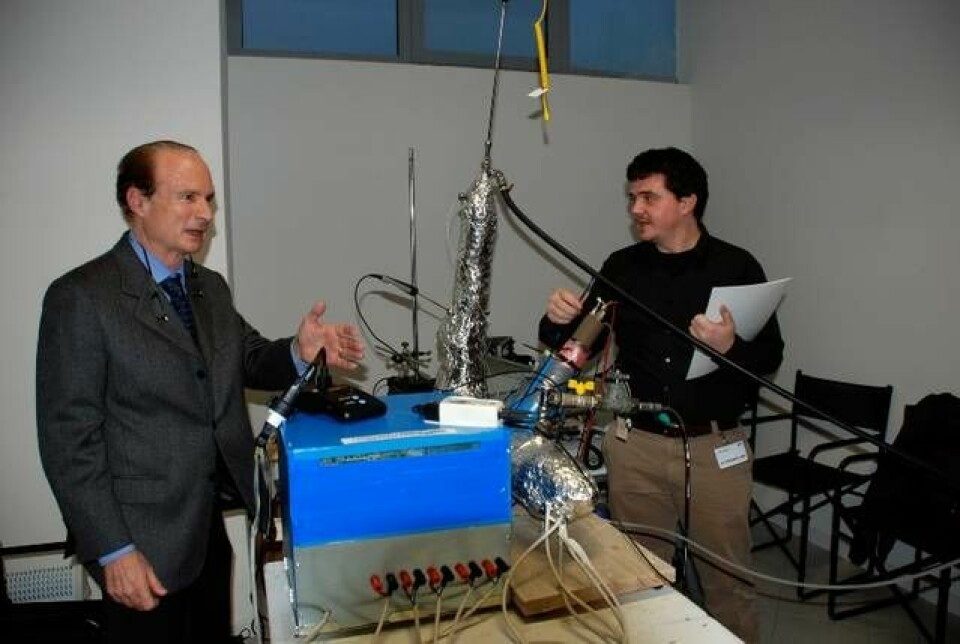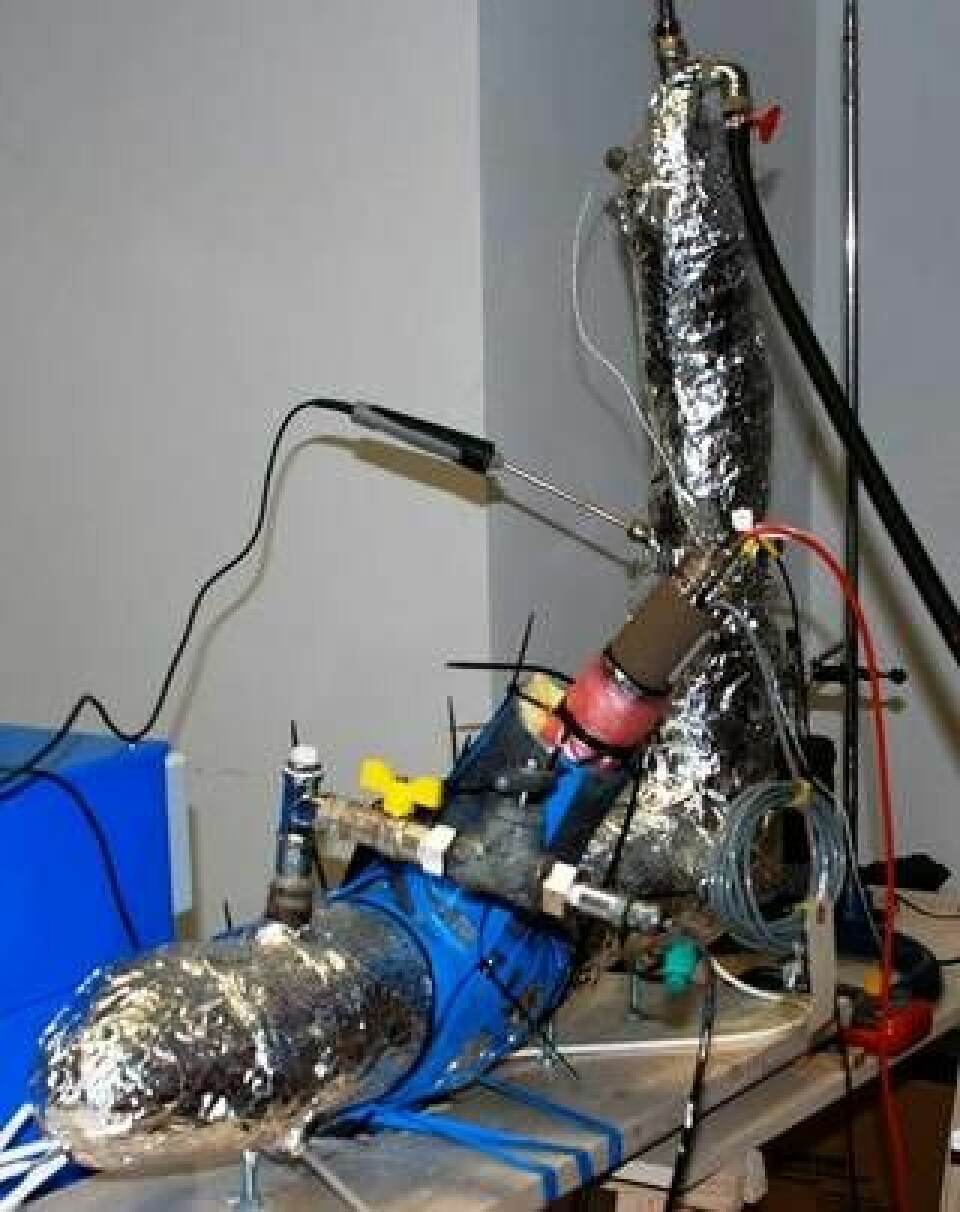“Here in the factory in Miami, we have one hundred reactors like the one we showed in Bologna, almost ready. The problems now have to do with authorization, but I expect that the heating plant in Athens will be inaugurated in September or October 2011,” Rossi told Ny Teknik, calling from Miami, FL.
(Update: Read our interview with the Greek company Defkalion Green Technologies here).
The demonstration of the ‘energy catalyzer,’ as Rossi prefers to call it, was made in Bologna on the 14th of January, 2011, under the supervision of independent scientific representatives of Bologna University.
For about an hour it produced approximately 10 kilowatts of net power, loaded with one gram of nickel powder pressurized with hydrogen. The inventors calculate an available energy equivalent to 517
tons
(we have noted that the result should be 517 kg. Rossi has now confirmed that this is an error in the application.) of oil per gram of nickel.
Physicist researcher Giuseppe Levi, one of the observers, drew these conclusions in his report on the experiment:
“The amount of power and energy produced during both tests is indeed impressive and, together with the self-sustaining state reached during [Test 1] could be an indication that the system is working as a new type of energy source.”
(Read our interview with Levi here).
The problem was that the observers were not allowed to examine the reactor. Yet Giuseppe Levi considers combustion as a hidden energy source to be unlikely. One possible explanation is a kind of cold fusion between nickel and hydrogen, though the inventor Rossi and his advisor Professor Sergio Focardi until now have said that they lack a clear theory, at least officially.
“The truth is a little different. I have very specific ideas about the theoretical aspects. But they are so closely related to an industrial secret that I prefer to keep them secret,” Rossi explained.
Ny Teknik: We talked with the Swedish physicist Hanno Essén who has the hypothesis that it may involve runaway electrons at relativistic speeds (near speed of light) that form a kind of plasma (his paper here). Would that be possible?
“It is certainly a very intelligent theory. The person who says this surely has a very high level of preparation. It demonstrates that we must be very careful not to expose anything before the patent is granted,” Rossi answered.
Rossi made a patent application in his and his wife’s name in August 2008. He expects some form of approval in a few months.
“We need to see which claims in the patent application will be approved, because if fundamental key claims are approved than we can quietly drop our silence on what we believe may be valuable industrial secrets. If, on the other hand, crucial claims are not approved, we will necessarily have to maintain our silence on the industrial secrets.”
“It is clear, you’ll surely point out, that once we start selling the product the secrets will be revealed. I know that, too, but of course we will try to exploit it commercially as far as possible. And then it is impossible to avoid the reality that sooner or later it will be copied.”
Rossi admits that the demonstration with a ‘secret bottle’ created much uncertainty. “Therefore, I would have preferred to wait.”
It seems instead to have been Rossi’s scientific adviser over the past four years, Professor Sergio Focardi, who wanted to show off the results.
“I would have done it earlier. You know, when you achieve results it is gratifying to spread the word on them. Moreover, I am 78 years old and cannot wait that long,” Focardi told Ny Teknik.
He mentions the famous experiments by researchers Martin Fleischmann and Stanley Pons on cold fusion between deuterium and palladium in 1989 as a start of the story. Focardi himself collaborated with the Italian professor Piantelli at the University Of Siena, Italy, using nickel and hydrogen.
“We got modest results – not as big as now – that we published, while those who continued with palladium and deuterium never saw anything at all.”
Though not even Focardi knows exactly how Rossi’s apparatus is constructed, he is convinced of its importance.
“I believe, forgive me if I say it, that this is the greatest discovery in human history. For the results will be immense: clean energy at (almost) zero cost.”
Ny Teknik: Do you think it will be rewarded the Nobel Prize?
“If they award us the Nobel Prize, I think it would be well deserved. But that’s not what interests me. You know, rewards are something I usually give myself.”
Rossi is the sole constructor of the unit. Only he and those working on building the reactors at the company Leonardo Corporation’s facilities in Miami, FL (Leonardo Corporation was founded by Rossi in 1997) know exactly how it is designed.
The secret lies primarily in materials acting as some kind of catalysts.
“That’s the crucial point that makes it work – not in a laboratory for a few seconds producing a few watts, but as a device producing continuously. Just to have nickel react with hydrogen is no news. That has been done for years,” Rossi said.
Ny Teknik: What response do you expect from the oil industry?
“Oil companies are controlled by highly intelligent people and I expect an intelligent response, a response aimed at integrating this new energy source with others. We should not think that this is a miracle solution that sweeps away all others–you know, ‘here comes Superman!’ This is surely a very important energy source whose destiny is to be integrated with others. Therefore I wouldn’t be surprised if deals will be made,” Rossi said.
- - - -
READ MORE: Our complete coverage on Rossi's E-cat can be found here.
- - - -
The editorial staff voted for skepticism
Ny Teknik’s editorial staff did a quick show of hands on Rossi’s energy source. The result: two-thirds do not believe in it. Rossi responded.
“I feel honored that one-third is willing not to dismiss it immediately. That’s actually a high percentage. I am delighted, not least because we’re talking about Sweden, which we all know has world-class engineering. In Bologna, where everyone knows about our apparatus, we have much lower percentages,” Rossi said.
“And that's normal. Because once science is structured on certain assumptions, it is ready to evolve, but only on the foundations of a robust and important skepticism – before you rewrite a book you must verify that the prerequisites are actually there.”
“But the final word will be the market’s. Once that there are plants around that work, you can of course say that they do not work only in theory – it is just like the famous story of the bumblebee that theoretically cannot fly. But since it doesn’t know physics it flies anyway.”
- - - -
READ MORE: Our complete coverage on Rossi's E-cat can be found here.
Demonstrated in Bologna on January 14, 2011.
Patent pending: WO/2009/125444
Read the inventors' paper on the technology (not accepted by main scentific journals but published on Rossi's own web site Journal of Nuclear Physics).
Into a metal tube of 1-2 liters containing unknown catalysts approximately one gram of 99.999 percent pure nickel powder is introduced. It’s then pressurized with hydrogen to between 2 and 20 bar.
The contents are heated by an electrical resistance source at a power of about 1 kW, which is then lowered to about 700 W.
The reaction starts producing 10-12 kW of power, which in Bologna was used to heat water to 101 degrees Centigrade. During the demonstration, 13 liters of water were vaporized in approximately one hour.
The reaction forms copper – according to Rossi, higher levels of copper than nickel have been detected after the reaction.
The observers, who could freely choose their measuring instruments, stated that:- they attached the hydrogen to the reactor themselves- less than one gram of hydrogen was consumed- no hidden connections were detected
According to the patent application, the available energy is equivalent to 517 tons (we have noted that the result should be 517 kg. Rossi has now confirmed that this is an error in the application.) of oil per gram of nickel.
The cost of the energy catalyzers is calculated to be about 2,000 Euro per installed kW. Production cost of the energy is, according to the inventors, less than 1 cent per kWh.
The energy catalyzers can be connected in series to gradually raise the temperature to about 500 degrees C (which produce vapor at the pressure of 55 bar, for turbine operation), and connected in parallel for greater energy production.
The energy catalyzers are manufactured at Leonardo Corporation’s factory in Miami. Additional production plants are, according to Rossi, being built in Greece.
One customer – a newly formed consortium of energy distributors – should exist in Greece, and two others in the United States. These customers will sell energy catalyzers in Europe and the USA.
Andrea Rossi, founder and chief technology officer at Leonardo Corporation, gets a royalty on sales. Sergio Focardi has a commercial agreement with Rossi.
Leonardo Corporation’s main business presently consists of generators fueled by vegetable oil and animal fats which are also suplied by the company. The technology has connections with Rossi’s former business as a pioneer within biodiesel (see below).
- - - -
Andrea Rossi
Born June 3, 1950
Doctor's Degree in Philosophy (Dottore Magistrale in Filosofia) from the Università Degli Studi Di Milan.
Rossi was, with his company Petroldragon, a pioneer within biofuel in the ‘80s. It was produced from recycled organic household and industrial waste.
The business became illegal in 1987 after an amendment to the Italian laws on waste treatment.
Rossi, who was then ruined, claims that there was a link to the Italian Mafia’s wakening interest in waste management at the time (see Italian Wikipedia, and Rossi's own site: www.ingandrearossi.com).
- - - -
Sergio Focardi
Born July 6, 1932
Professor Emeritus of Experimental Physics at the Università di Bologna.
Has done research within experimental physics on strong, weak, electromagnetic and gravitational interaction.
Author of a dozen books of physics and more than 70 scientific articles.


























































